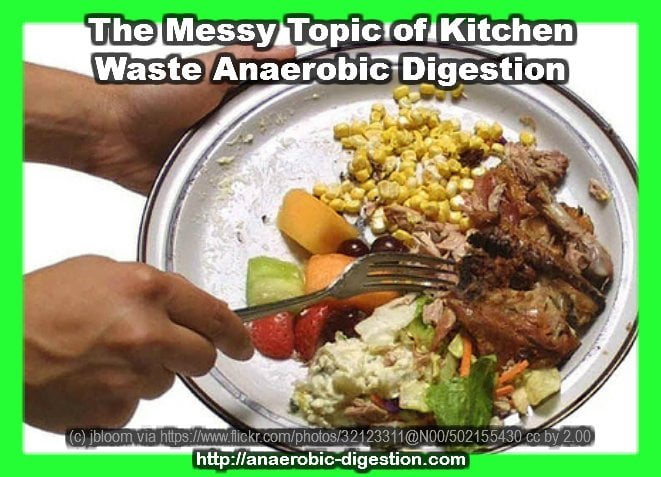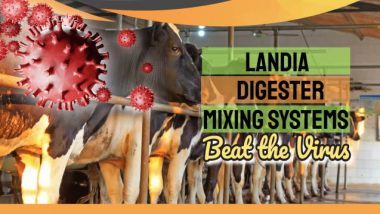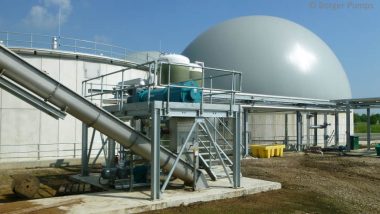The anaerobic digestion of kitchen waste (also known as food waste anaerobic digestion) has become of great interest in recent years due to the high organic removal rates and positive net energy balance which can be achieved in well designed and competently operated anaerobic digestion plants.
Anaerobic digestion is recognised by the UK government, Defra, the Welsh Assembly, the Scottish Parliament, Friends of the Earth and the National Farmers Union as the best method for food waste recycling – and also dealing with farm waste and sewage sludge. The word anaerobic actually means ‘in the absence of oxygen’. The biogas naturally created in the sealed digester tanks is used as a fuel in a CHP (Combined Heat and Power) Unit to generate renewable energy (i. e. electricity and heat). What’s left from the process is a nutrient-rich biofertiliser which is pasteurised to kill any pathogens and then stored in large covered tanks ready to be applied twice a year on farmland in place of fossil fuel-derived fertilisers. Every tonne of food waste recycled by anaerobic digestion as an alternative to landfill prevents between 0. 5 and 1. 0 tonnes of CO2 entering the atmosphere, which is one of the many benefits of anaerobic digestion.
Kitchen waste can be anaerobically digested at all scales, from individual household biogas digester units to large regional facilities built by groups of local authorities which combine together to provide the necessary funding. We will discuss the large scale anaerobic digestion of kitchen waste (Municipal Food Waste) first, and small scale down to individual home digesters second.
Anaerobic Digestion of Kitchen Waste After Household Collection (Municipal Food Waste)
Anaerobic Digestion of Kitchen Waste in regional and district biogas plants after household (kerbside) collection, makes a lot of sense for all urban communities. This is even more so for communities which have always prepared a lot of their own food, especially where much of it is from vegetables. In these circumstances, there is a lot of vegetable kitchen waste from food preparation (from carrot tops to unwanted root material), and there is an economy of scale. Travel distances can be small between the origin of the waste and the biogas plant where it is digested in cities where population densities are high.
However, anaerobic digestion of kitchen waste makes less sense for communities in the west which are located in sparsely populated rural areas. The cost of the collection of kitchen waste can be high for such communities, and the environmental benefits may even become close to negligible in low population areas remote from a food waste anaerobic digestion plant. That is because the benefit from the renewable biogas energy produced by anaerobic digestion can be negated by the fuel used in collection and transport to get the out-of-date food to the AD plants. AD plants are usually quite large in the west and on average each plant serves more than 150,000 homes, so they are quite few and far between.
However, having made this proviso, kitchen waste collections which take the kitchen waste to anaerobic digestion plants in towns and cities are increasingly being implemented and doing so is certainly environmentally beneficial although the dis-benefit in terms of disposal cost is generally still quite high. A gate fee is charged in the UK by the biogas plant operators to cover their costs.
When the alternative to separate food waste collection, would be sending this food to a landfill, the cost per unit of weight for disposal to a food waste digester is normally substantially lower than landfill charges. Landfill tax alone, in the UK is close to £100 per tonne (2020), whereas the gate fee charged for food waste is more typically in the range £30 to £40/tonne.
Anaerobic Digestion of Kitchen Waste by Individuals, Community Groups and the Food Industry/ Restaurants/ Catering Industry
So, now let's consider small to medium-scale anaerobic digestion facilities, in the context of kitchen waste anaerobic digestion, by individuals, businesses, and community groups.
Here we are referring to small to medium size anaerobic digestion plants run by interested individuals in their own homes and mall business premises, and also sometimes by the community. Urban and rural anaerobic digestion plants do exist in many countries to serve between 10 and 1,000 families. If run well they can provide for very energy-efficient digestion when the biogas is purified and sold or used on-site. At the same time, the output of fertilizer materials can be productively used (subject to Animal By-products Regulations compliance), and unused heat may be used to provide CHP (Combined Heat and Power). These projects can become real flagship schemes, showing others what is possible.
In addition to the increasing adoption of anaerobic digestion of kitchen waste in the municipal waste scene, kitchen waste is also digested in the private business/commercial waste sector. Many food producers are starting to anaerobically digest their own kitchen wastes at factories where they prepare processed foods, and of course, many restaurants and corporate catering facilities anaerobically digest their own kitchen waste.
The Advantages and Disadvantages of Anaerobic Digestion Kitchen Waste
The advantages of anaerobic digestion of kitchen waste can be listed as follows:
- Waste is diverted away from landfills where kitchen waste is the highest single waste type, other than garden waste (if landfilled) contributing to methane gas emissions. Methane on landfills can be dangerous (due to fires and explosion risks), and certainly is a major contributor to overall global greenhouse gas emissions.
- Kitchen waste has a high calorific value (lots of heat is bound-up in food) so when fed into an anaerobic digestion plant it produces a lot of biogas. This biogas is a wonderful fuel and can be sold in many forms, either without being purified first or after purification when it becomes a renewable form of the “natural gas” pumped into the vast majority of people's homes every day.
- The renewable energy produced is both made very close to where it is used (which saves on transport energy use and cost), and a clean energy source not producing pollution where it is burnt. Meaning that it can be used to fuel town and city buses and trucks in a way which reduces city and urban air pollution.
- The energy produced, unlike wind, and solar power is available day and night 24/7, so it is much more valuable to the community than power sources that cannot be relied upon to provide power at any time, and only do so except when climatic conditions are right.
The disadvantages of anaerobic digestion of kitchen waste are:
- Cost: It is more expensive to digest this waste anaerobically than use alternative methods.
- Transport: Use of vehicles to collect the food waste from kitchens and homes, take it to the AD process facility, and dispose of the output materials, causes potential odours and increases road congestion.
The issue of anaerobic digestion kitchen waste is a live one online at the moment, so we thought that after reading our article you might like to continue reading the following articles:
Anaerobic Digestion Benefits
With rapid population growth and industrialization, the amount of organic waste we produce has greatly increased. Organic waste is produced in many forms like food waste, human and animal waste, and agricultural waste. Organic waste is not actually a ‘waste' if appropriately handled… Kitchen waste may contain non-organic material like plastic-packaging, which cannot be digested or composted. Human and animal faecal waste; Agricultural waste: via … Energy Recyclers
Anaerobic Co-Digestion of Mixed Kitchen Wastes and Buffalo Dung
A huge amount of plant and animal origin organic wastes are being generated daily throughout the world whose management is challenging. Improper management will produce foul odour and pollutants which cause an ill effect on the health of living beings. Nature put microorganisms in almost everywhere, where they degrade organic waste. They use utilize the waste materials for their growth. Reference: Pradip B. Acharya* and Prateek Shilpkar. Biogas Research and Extension Centre and Department of Microbiology, Gujarat Vidyapith, Sadara, Dist.- Gandhinagar, Gujarat- …
Some microorganisms which digest (or break-down organic material into simpler compounds) are aerobic whereas some are anaerobic. It was found by research that anaerobic digestion is superior to aerobic process because it requires low input cost, can be made to be easy in operation and also produces biogas. The process was initially used to digest animal dung because it was available in huge quantities. Many plant and industrial wastes were trialled successfully, and the result has been the realisation that Kitchen wastes can be used for biogas production. A laboratory study was undertaken to find out the suitability of co-digestion of mixed kitchen wastes with buffalo dung for biogas production. Credit to: Anaerobic Co-Digestion …
Biogas Plant Using Kitchen and Food Waste – Instructables
Long back we posted an instructable on how to construct a prototype of a Biogas plant, using 50-litre capacity tank as a digester, which you can see. That was my first instructable and people are still commenting and asking me for guidance on Biogas plants for home use … This process is known as anaerobic digestion. Methane is a colourless and odourless gas and is highly flammable. (It is Hydrogen Sulphide that smells bad)
The original article on this page was first posted in 2015.



Listen up! We keep on throwing perfectly good food away.
It’s massive.
Over 10 million tonnes of food are binned each year in the UK.
Have you any idea of the size of a million ton mountain…
I wish that the yanks would follow this example. Instead, they throw away 730 football stadiums of food a YEAR.